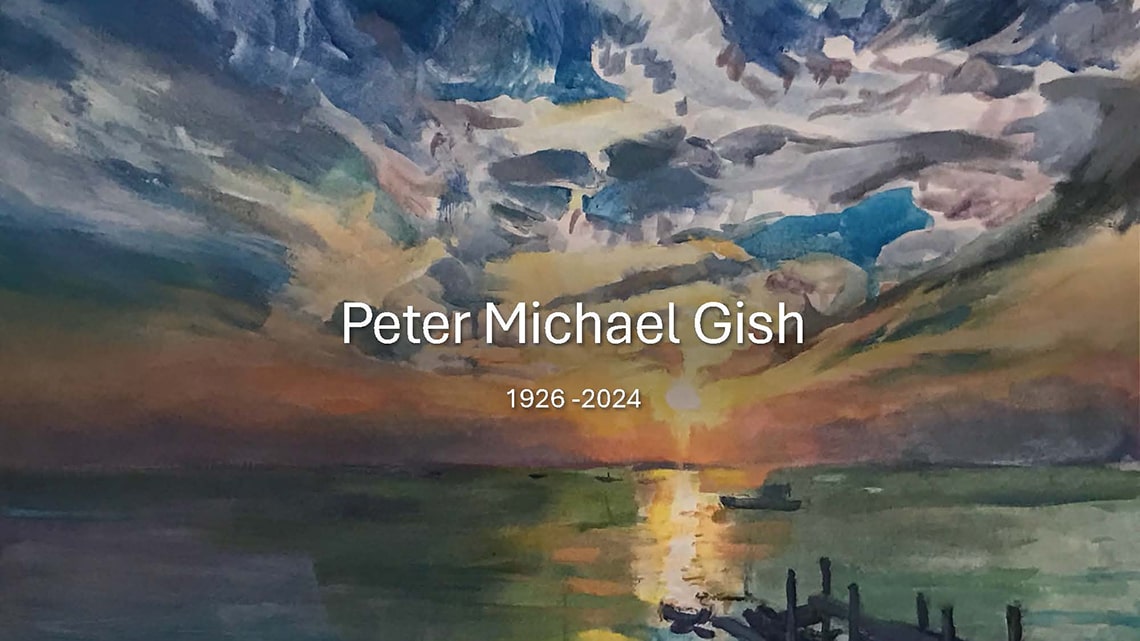Peter Michael Gish
1926-2024
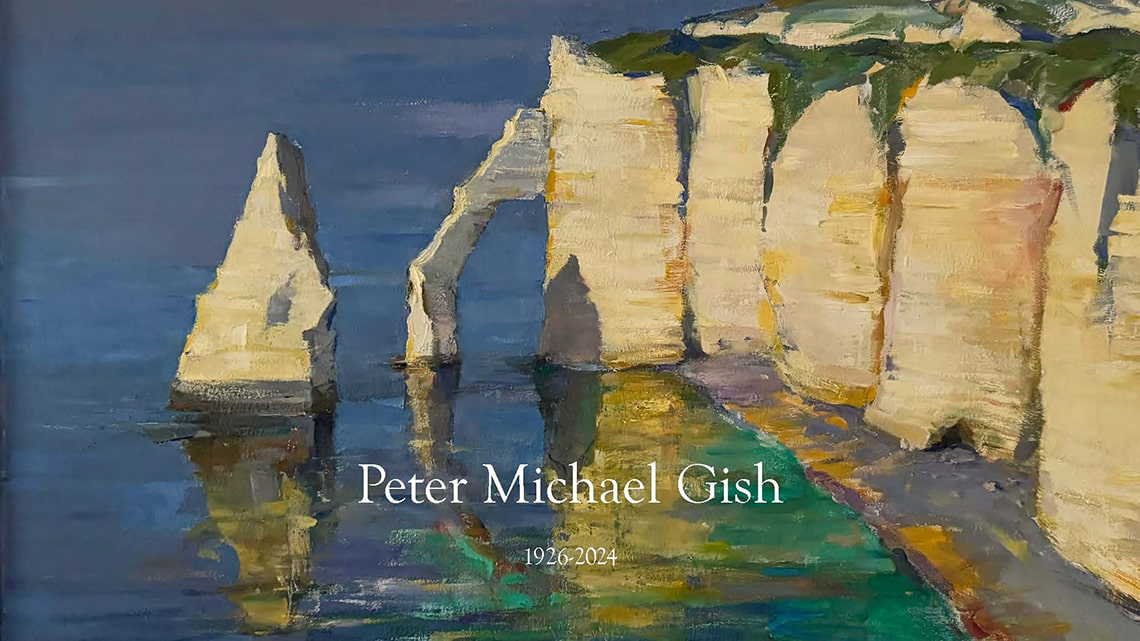
Peter Michael Gish lived a very full life. In preparing this testimonial, I was able to draw upon a lifetime of correspondence and photos as well as my own experiences as his son. Some of what I will share with you is in his own words. Elsewhere I draw upon the testimonial of others. My goal is to provide as comprehensive as possible an overview of his life. Because of the breadth and depth of his life journey, I have broken down the presentation into what I consider the three most important volumes of his life: Military, Art and Family.

- USMC Aviator
- Combat Artist
- Painter
- University Professor
- Father of 3
- Good Friend
- “Humanitarian”
Coast of Normandy @1988
++++++++++++++++++++++++++++++ MILITARY CAREER+++++++++++++++++++++++++++++
Born in New York City in 1926, Mike was raised in Westport, CT. His father had worked for Standard Oil in China after graduating from Dartmouth College in 1915. His mother was from the well-respected Baldwin family in Derby, CT. The detailed correspondence that Mike kept reveals a loving family with very close ties to each other.
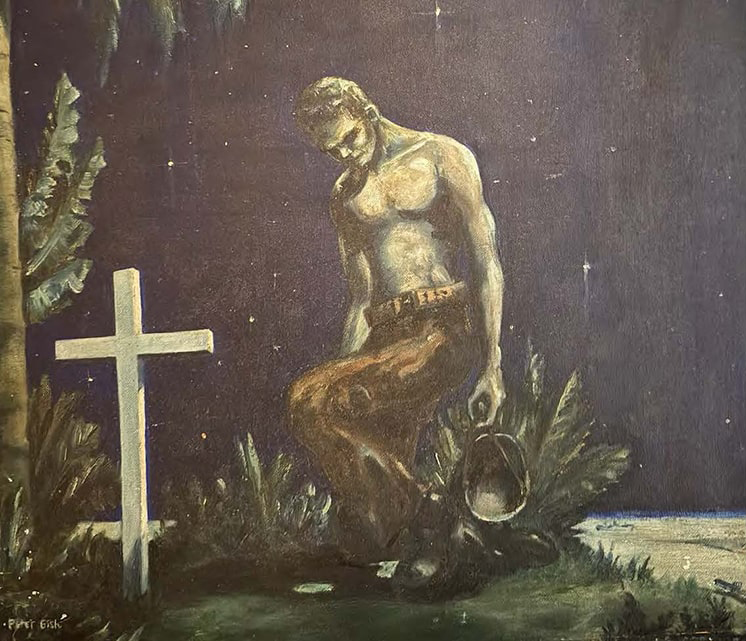
The death of Mike’s brother, Carl K. Gish II or “Jim,” was the defining moment of Mike’s life. A Private First Class in the US Marine Corps, Jim responded to a “cry for help” from an enemy soldier who ended up killing him on the beaches of Saipan on June 19, 1944, just before his 20th birthday. Years later, one of the Marines who was with Jim on Saipan wrote to Mike: “Jim’s death was the shocking end of my innocence…He was an exceptional young American. Brave and kind. A beautiful man.”
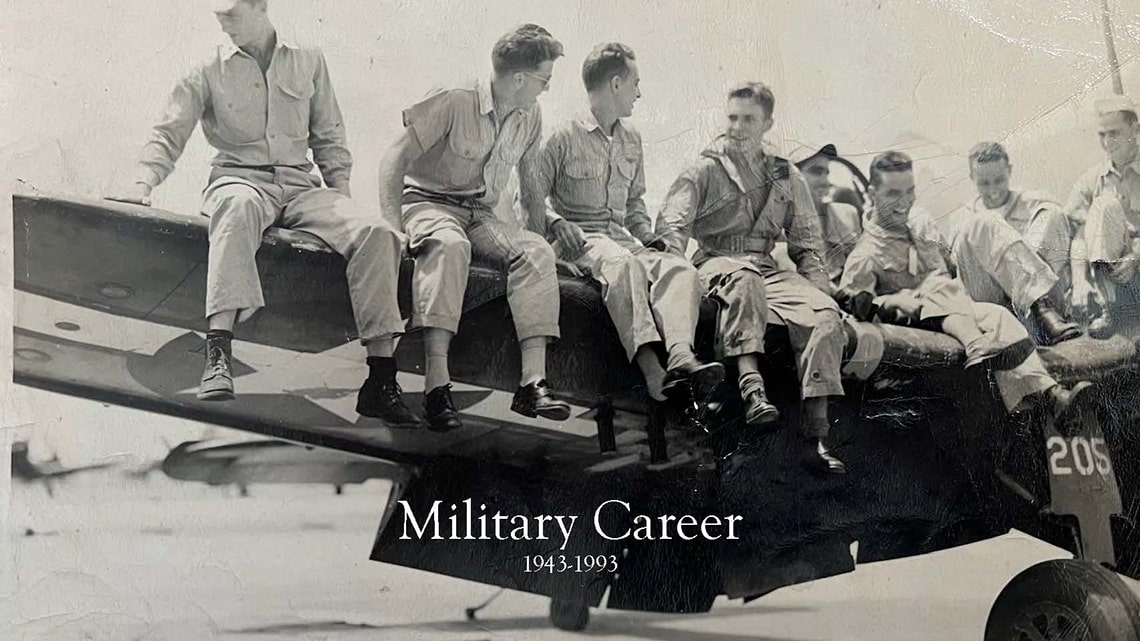
Mike’s decision to become an aviator was strongly influenced by his uncle, Charles F. Baldwin, who had flown in WW I for the U.S. forces and later flew reconnaissance for Standard Oil in Egypt (he also happened to be an artist). In a letter to Mike’s Parents in March 1945, Charles wrote: “[I told Mike that] I remember how we used to talk excitedly into the night about the day’s flying adventures. And I imagine you and your buddies are doing the same. It didn’t come easy to any of us at first… The main idea is to sit back and relax and enjoy your flying.”
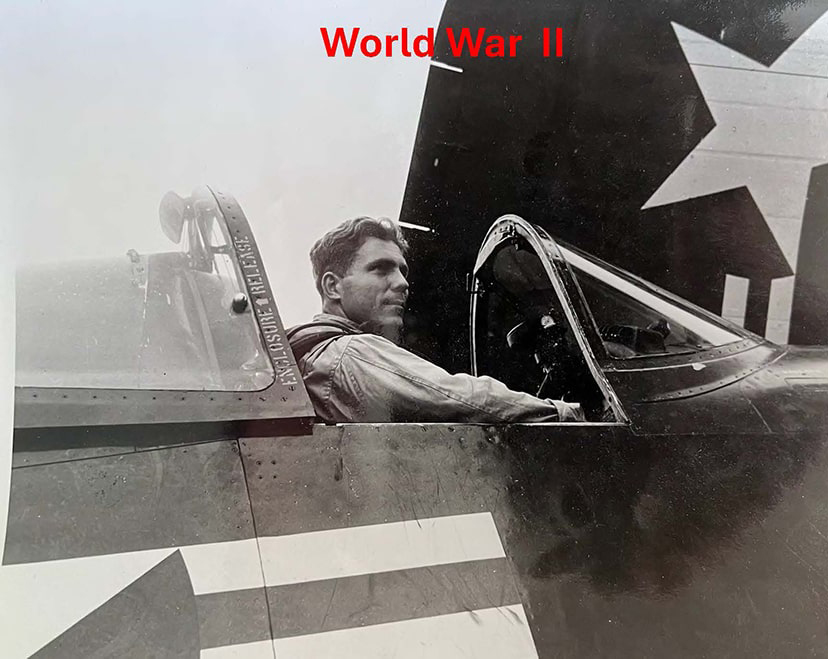
Mike had matriculated to Dartmouth College in 1943 at the age of 17 as part of the Naval Aviation V-5 Program (ROTC) at the same year his older brother had joined the Marines. Upon learning of the death of Jim, Mike left Dartmouth to accelerate and complete his aviation training with the Marines. Mike received his “wings” in 1946 just as the war was ending in Europe. He never saw active duty during the Second World War.

Mike was recalled to active duty during the Korean War, initially as a helicopter pilot and then later as an instructor. He commanded Marine Medium Helicopter Squadron 768 at Floyd Bennet Field in Long Island. This photo was taken in the late 50s showing that when Mike wasn’t flying an aircraft, he was painting it. Mike’s artwork started to draw the attention of senior officers in the Marine Corps.
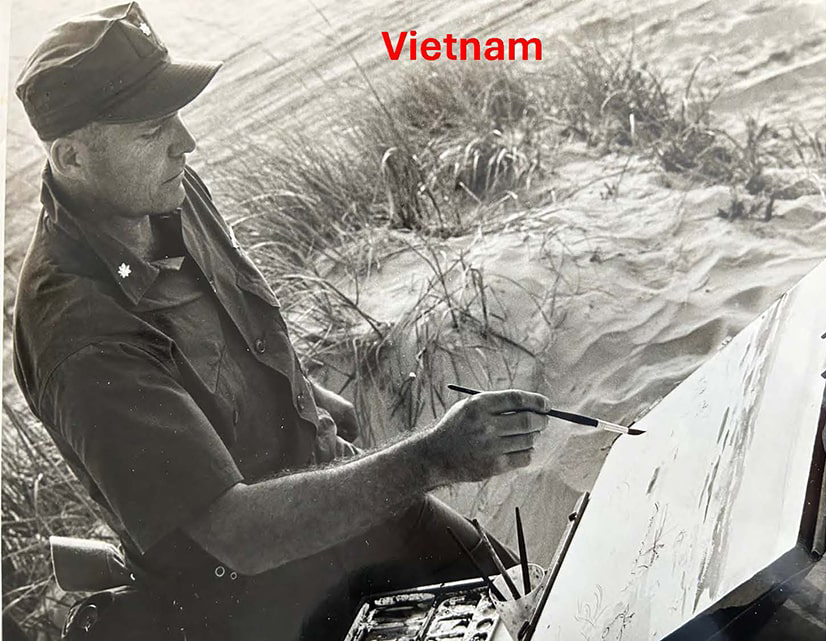
In 1967, Mike volunteered to be deployed to Vietnam as a combat artist. He was given full authority to decide which elements of the war he wanted to capture. Mike flew 24 combat missions in addition to painting and was eventually awarded the Air Medal in his capacity as a pilot. One of his paintings was the basis for the Vietnam Veterans Memorial poster in 1972.
These next images give a tiny sense of the breadth and depth of Mike’s experience in Vietnam. I have distinct memories of seeing these photos and paintings as a 6-year-old, witnessing as a child the vast body of artwork he produced in the wake of his tour of duty in Southeast Asia. The next four images are a small example of his work …

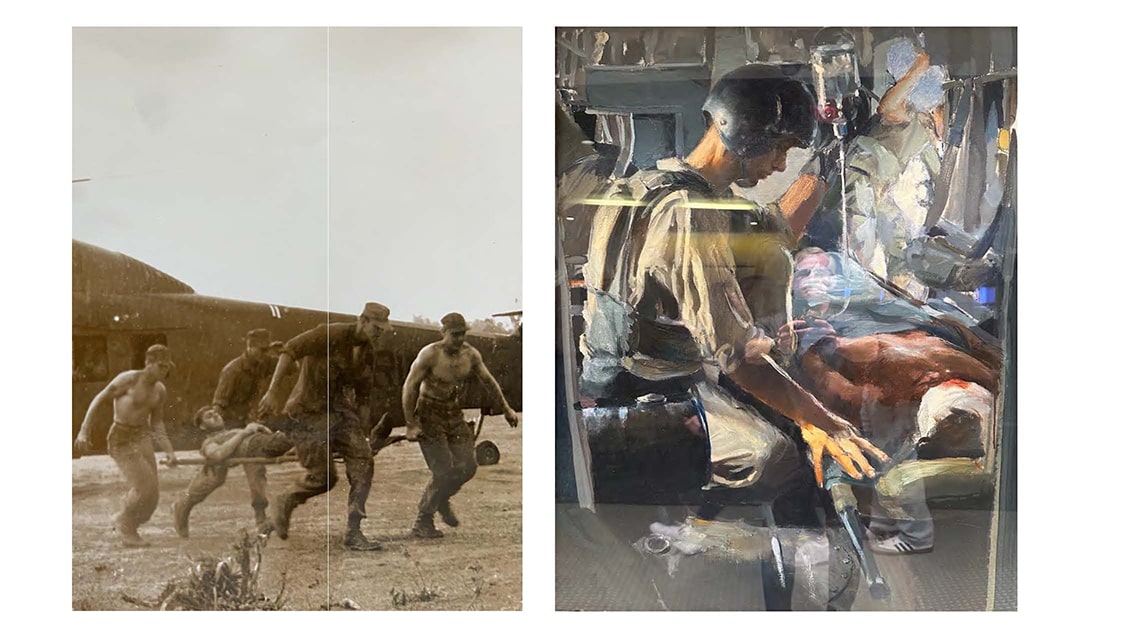
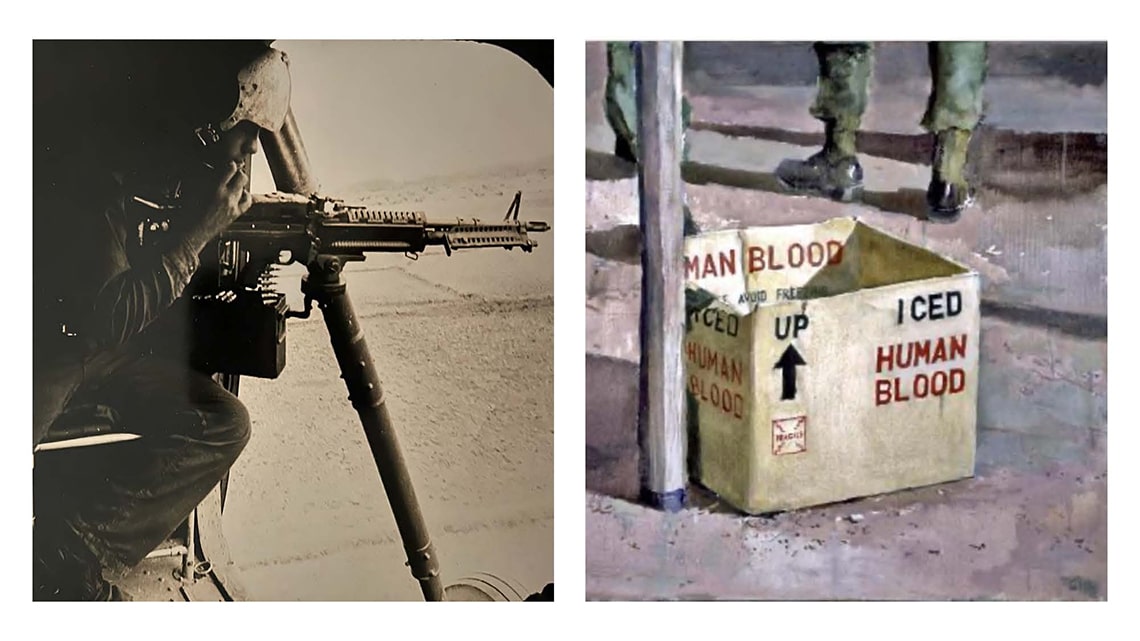
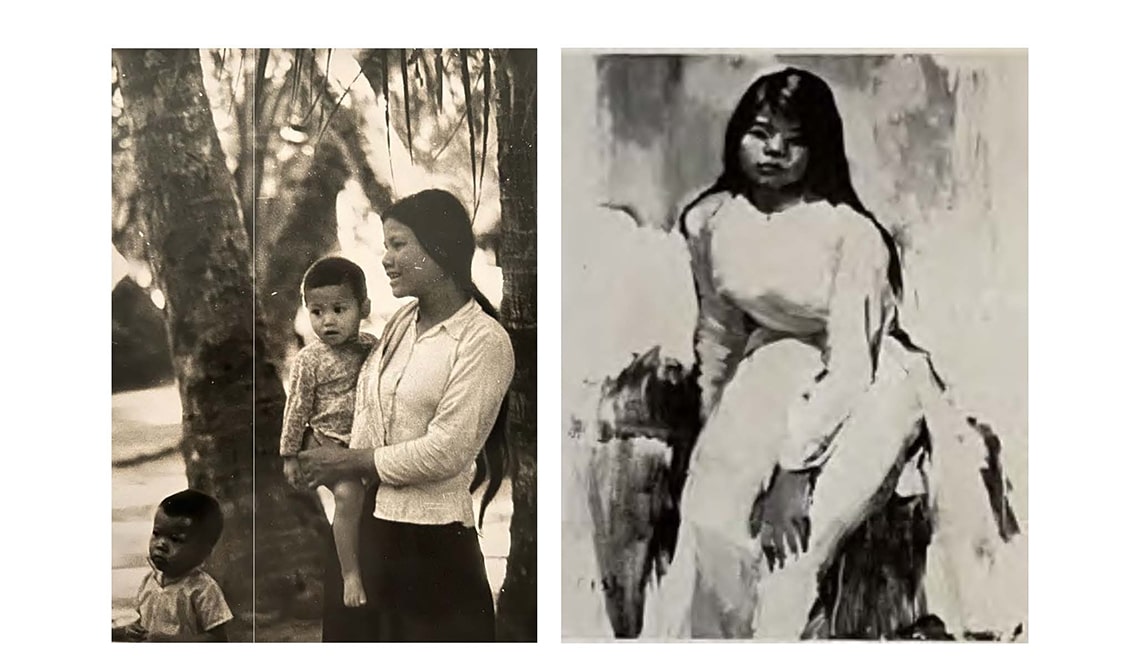
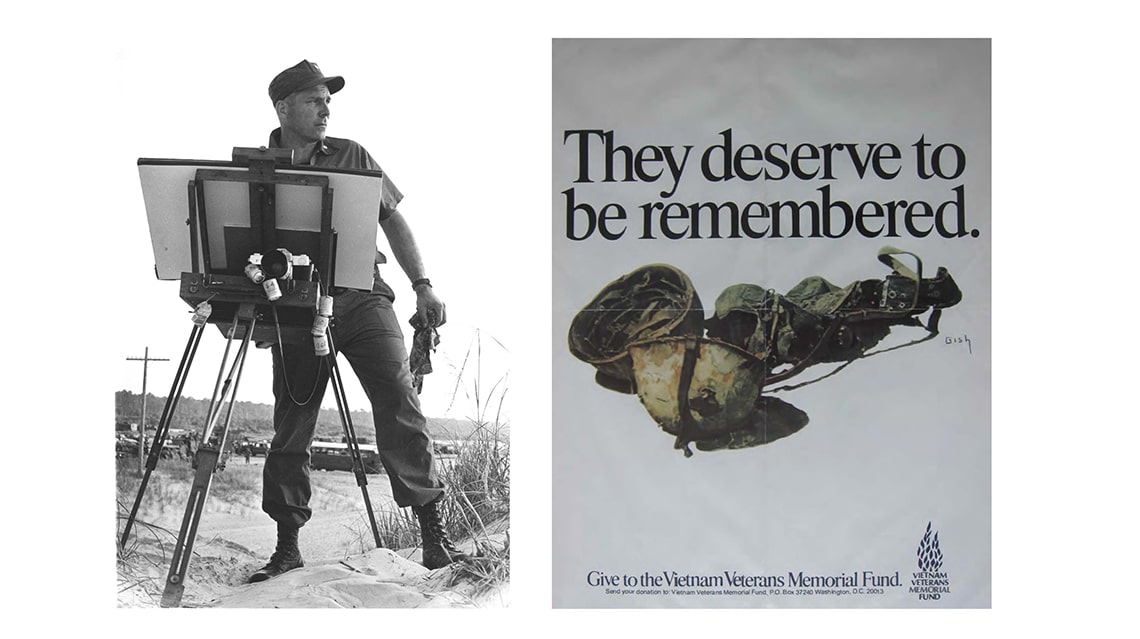
Mike would write several years later: “The hopelessness of our involvement [in Vietnam] overwhelmed me. Others have written of this, but to me it was very much the two sides of a coin; the beauty and the tragedy side by side every day… I was always conscious of the suffering, often of innocents, on the other side.” In a letter dated April 1968, the Commander of the CORDS medical team wrote: “Dear Colonel Gish, I know you said it would not be necessary to acknowledge each parcel of linens – which thanks to your kindness, we have been receiving … For the first time in the history of the Danang Hospital we now have enough sheets to change them daily on the burn ward…”
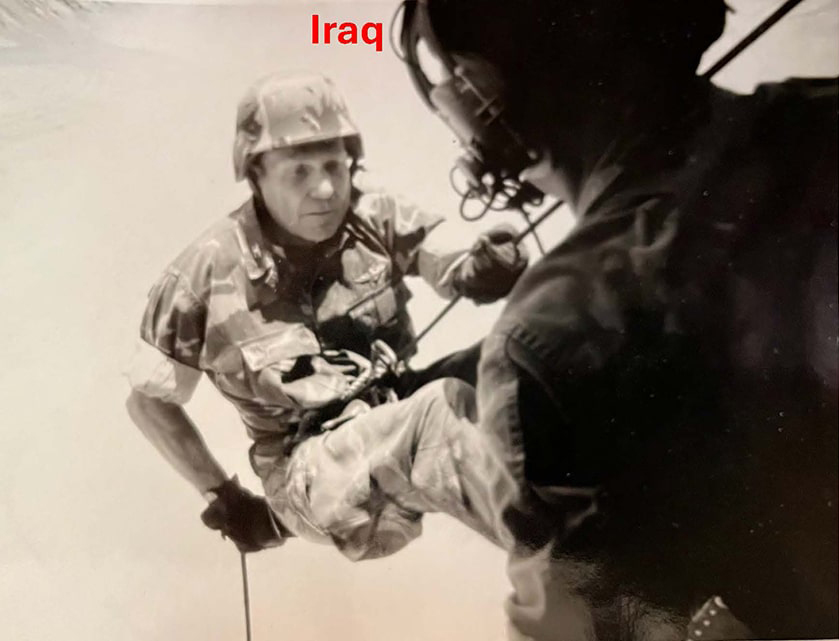
After retiring from teaching art at Fairfield University at the age of 65, Mike asked his Marine Corps ”buddies” in Washington if he could perform another tour of duty. He was formally reactivated with the Marines in June 1991 and sent to Northern Iraq as a combat artist during ”Operation Provide Comfort.”He documented the efforts of multinational forces sent to provide assistance to Kurdish refugees escaping Saddam Hussein’s troops. In this photo, Mike is rappelling out of a Sea King helicopter with a 9 mm Baretta strapped to his thigh. He was 65. When I saw the image, I said: “Dad, you should be the poster child for AARP.”
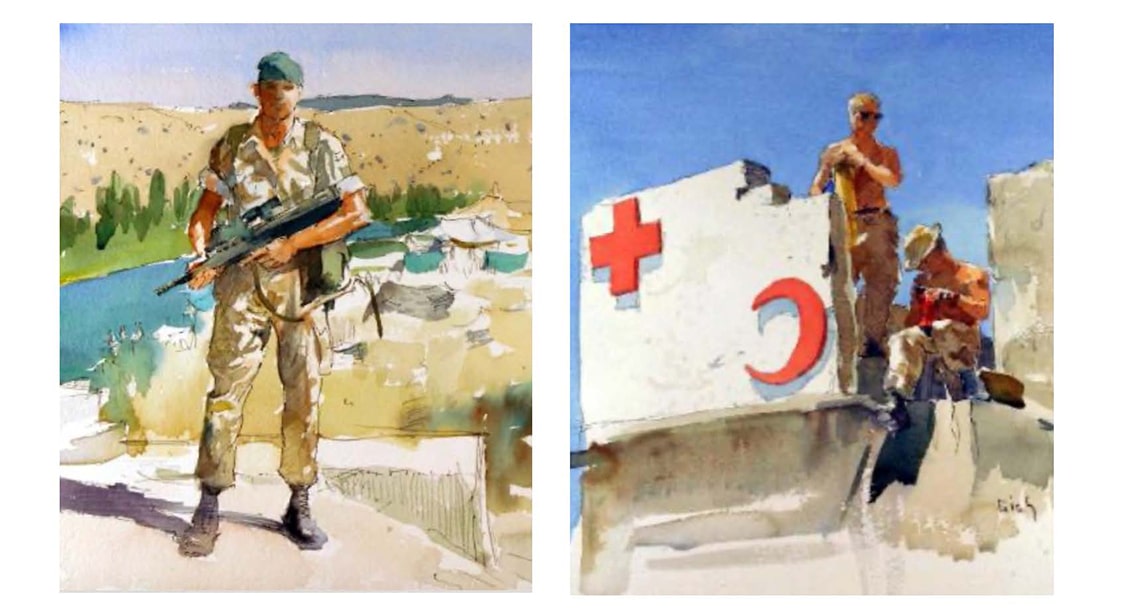
These two watercolors portray the protection of the Kurdish refugees as well as the hospitals that were set up for the displaced.
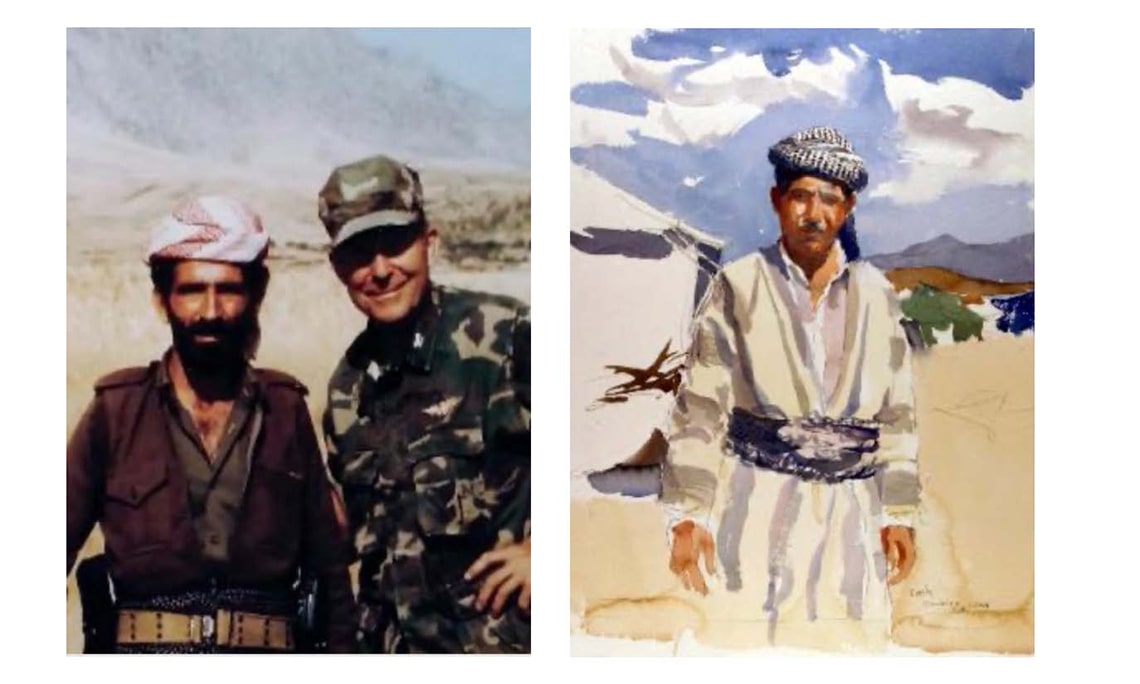
In this photo, Mike is seen with a Kurdish resistance fighter and the watercolor to the right shows the artwork he produced as a result of his interactions with the Kurdish leadership.
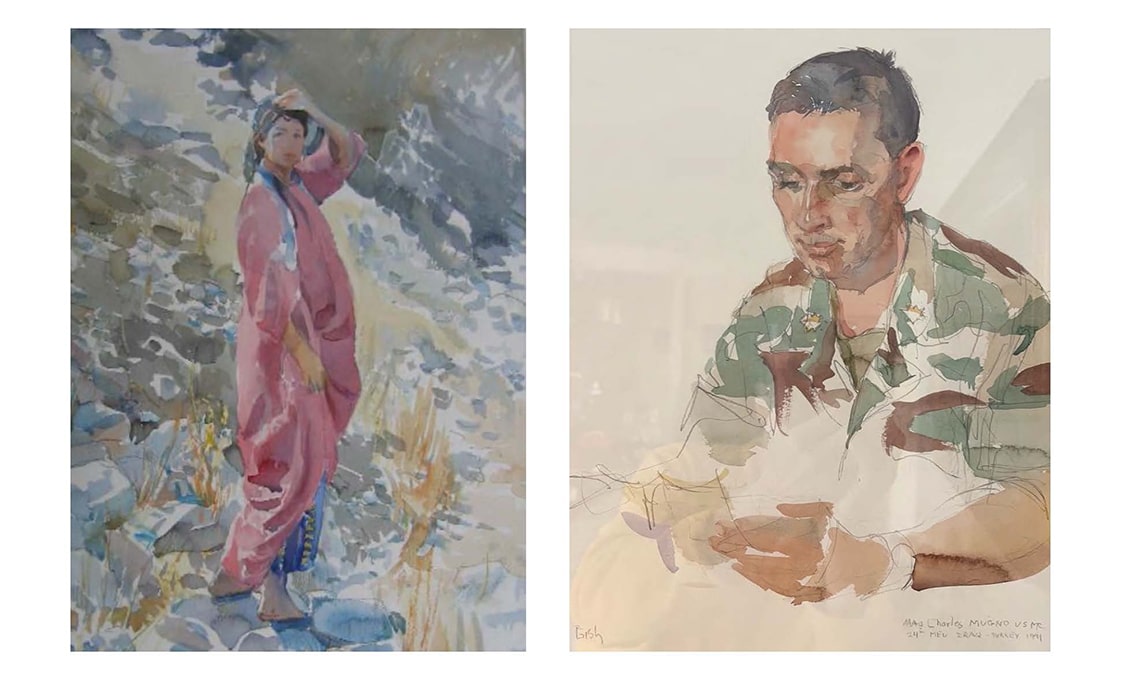
These next two works show a theme that was emblematic of Mike’s work as a combat artist. The first watercolor captures the scene of a Kurdish woman going to the river to get water. This second watercolor is of a Marine Corps Major who was with Mike in Iraq. Chuck Mugno wrote to me recently: “Your Dad was one of my best friends. He painted the attached image when we were in Iraq. My son, Michael, was born the day the war started, and I was reading a letter from home when he created the painting. Your Dad then attended my son’s wedding 24 years later.”
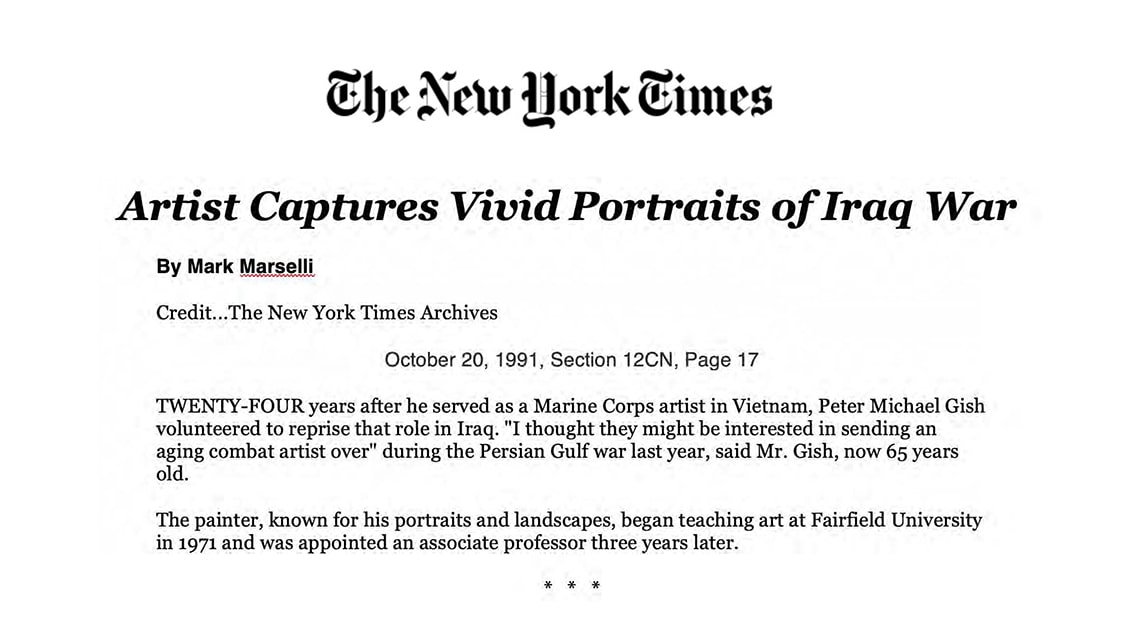
Mike’s combat art was regularly reported in newspapers and periodicals. This article appeared in the New York Times in 1991 after his tour of duty in Iraq.
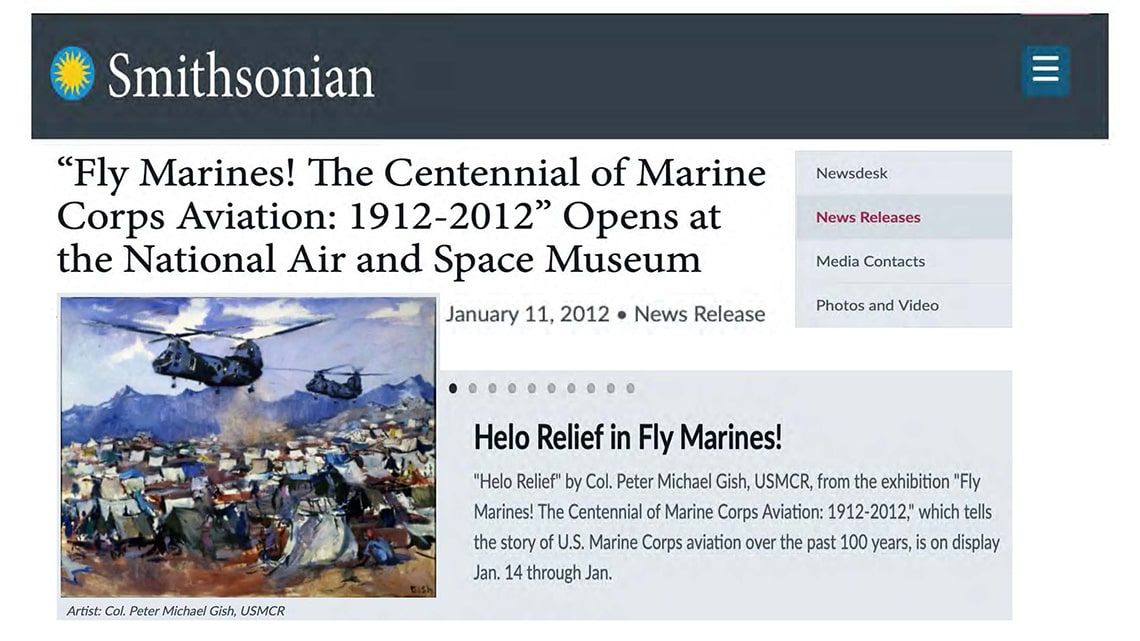
Many years after Iraq, the Smithsonian Air & Space Museum would hold a centennial retrospective on Marine Corps Aviation. The show featured one of the paintings that Mike had done showing helicopters bringing supplies to refugee camps in Northern Iraq, along with other artwork he had done of aircraft during the Korean and Vietnam Wars.
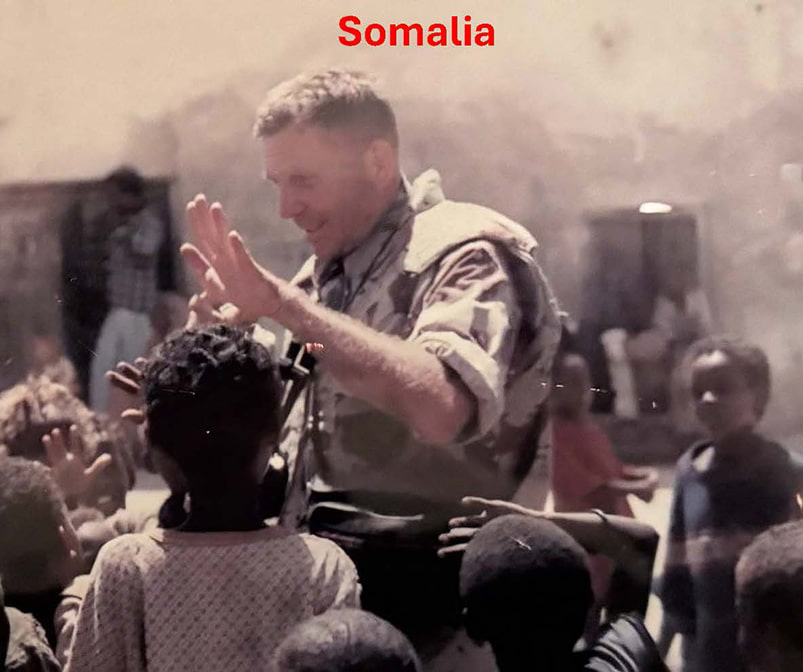
One year after Mike returned from Iraq, his Marine Corps ”buddies” in Washington asked him to go to Somalia. He didn’t really want to go but felt obliged given that the Marines had honored his request the previous year to return to active duty. Mike was formally put back on active duty in December 1992 and sent to Mogadishu as a combat artist during “Operation Restore Hope.” He documented the efforts of multinational forces to provide relief to starving refugees in war-torn Somalia. He was 67 at the time.
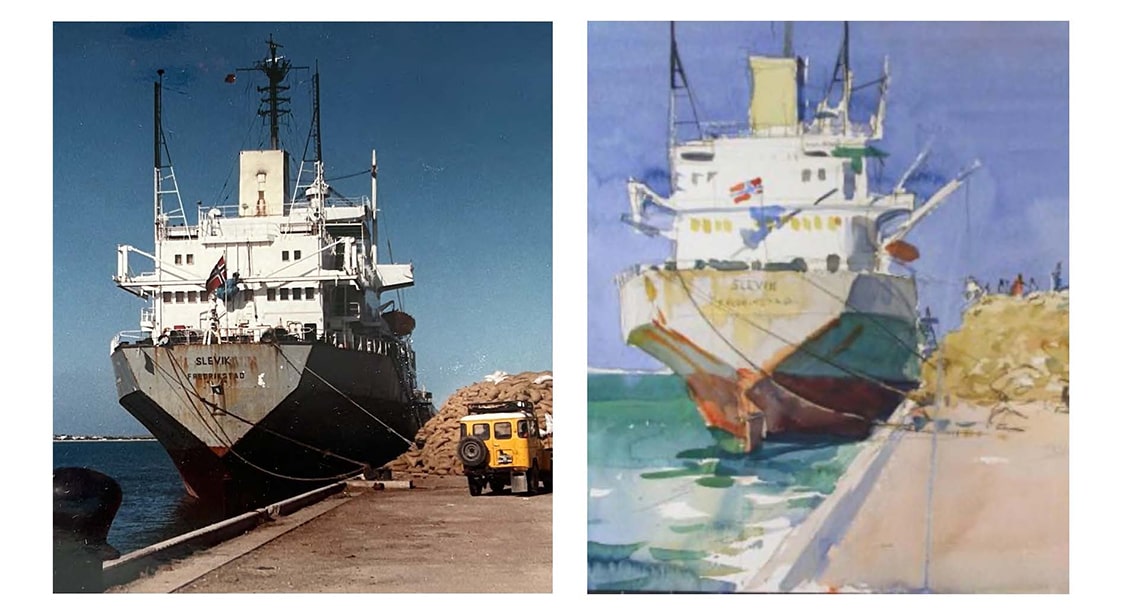
In this image, Mike painted the Norwegian ship Slevik unloading a precious cargo of grain to relieve the starving Somalian refugees in the port of Kismayo.

I was very struck by this photo of Mike painting at his easel near Mogadishu. It is as if he was emaciated by the immense suffering around him. The child was one of many images he painted.
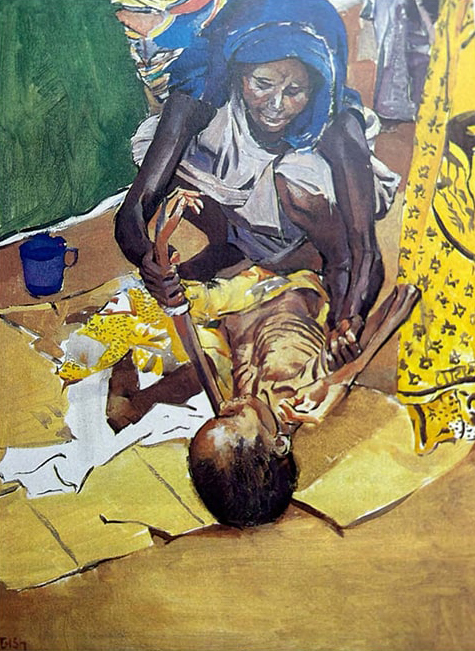
In one of his memoires of Somalia, Mike wrote in 1993: “If the commandant hadn’t told me [that] I was there to record all this, I never would have been able to do so. I was able to detach myself, finally, but it took some weeks to set up my stool inside the shelters where the children were dying. Then I just sat there and did it.”

Several years later, when asked by the Greenwich Times about his role in the Marine Corps, Mike responded: “The role of the combat artist is to document history, to record to the best of his means the truth of any engagement. Our work wasn’t based on hearsay, but rather on what we saw with our own eyes.” The Times went on to report that “Gish’s paintings, drawings and watercolors number about 150 of the 7,000 in the Marine Corps Collection.”
Mike was awarded the Meritorious Service Medal for his work in Somalia. In relevant part, the award states: “After being voluntarily recalled to active duty and deploying on short notice to a war-torn country in a total state of chaos, Colonel Gish involved himself with all aspects of the operation in order to totally capture the experience vividly then artistically. His participation included road convoys, weapons market sweeps, raids, civic actions and medical civil action…
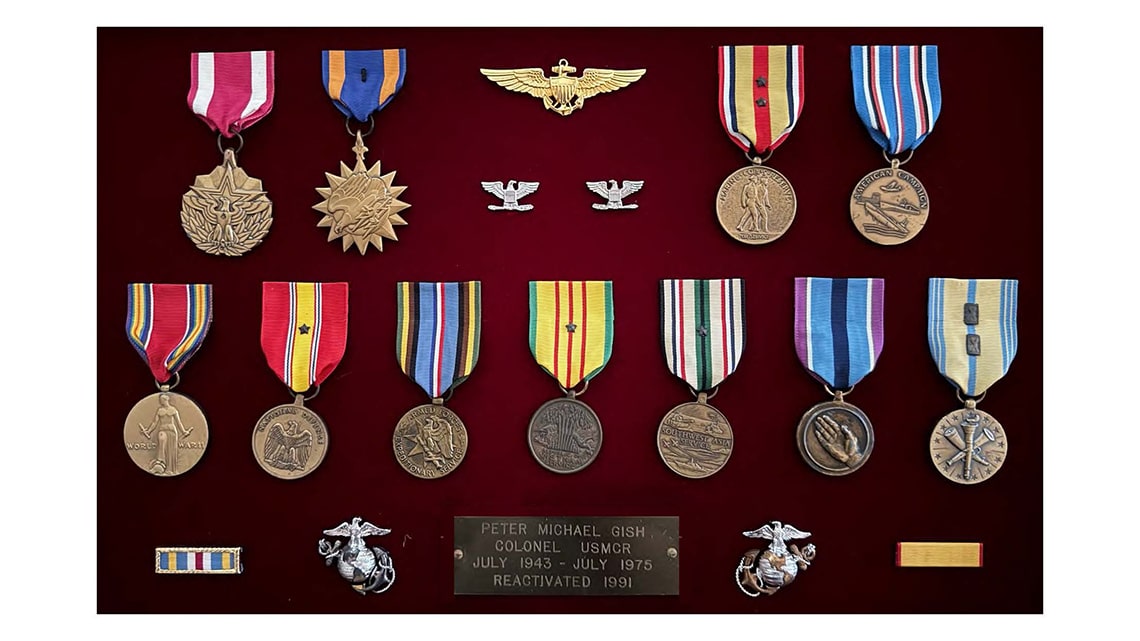
During his long military career, Mike was highly decorated and one of the longest serving members of the US Marine Corps. His older brother Jim would have been immensely proud of his accomplishments as an aviator and combat artist. While Mike was unable to save his brother from an early death in battle, he was able to rescue wounded soldiers in Vietnam and positively inspire three generations of Marines through his artwork.
+++++++++++++++++++++++++++++++ ART CAREER +++++++++++++++++++++++++++++++
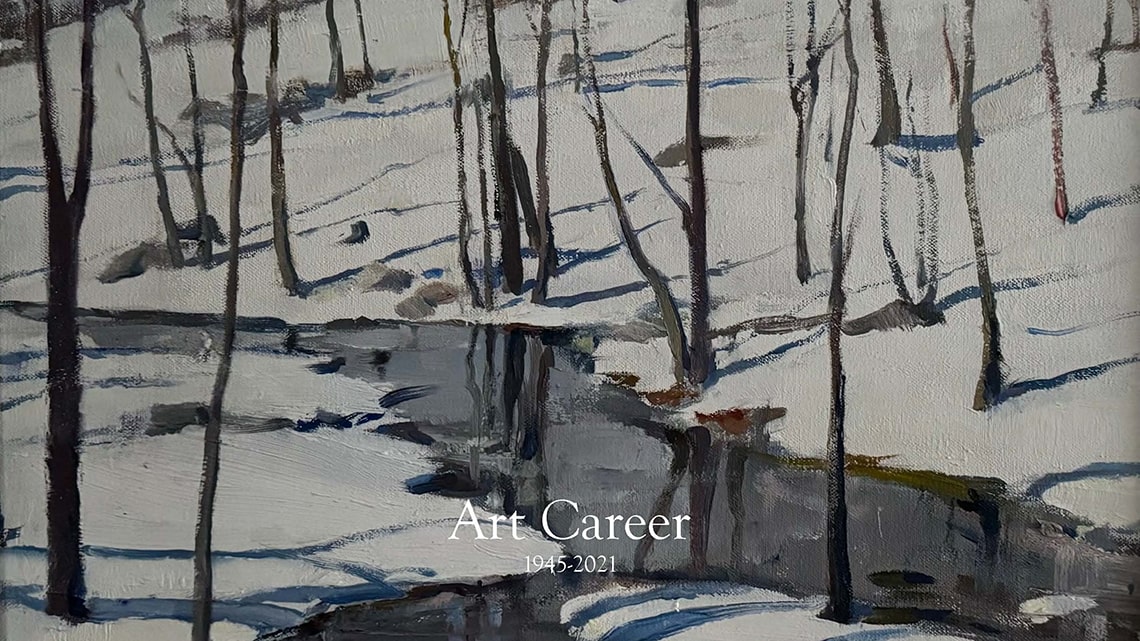
Mike had always been interested in art. His Uncle, Charles Baldwin, was a talented artist and had a big influence on Mike. In one of his biographies, Mike writes: “I decided to be a full-time painter in 1945 while still in Service as a pilot with the Marine Corps. Until this time, I had painted for my own amusement.” He returned to Dartmouth College a year later to complete his undergraduate degree.
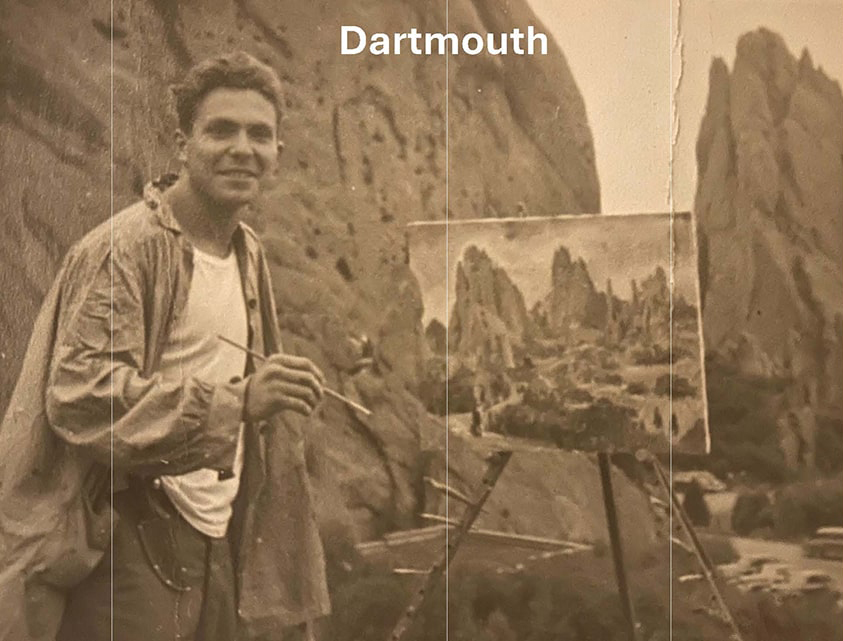
Mike graduated from Dartmouth College with a B.A. in Fine Art in 1949. During his time on campus, he studied with Artist in Residence, Paul Sample, who remained a life-long friend. After graduating from Dartmouth, Mike painted the locally famous “Vermont Murals” here in White River Junction in 1950 (David will speak about the muruals a bit later). In 1951, Mike attended the Ecole Nationale Superieure des Beaux-Arts in Paris as a visiting student.
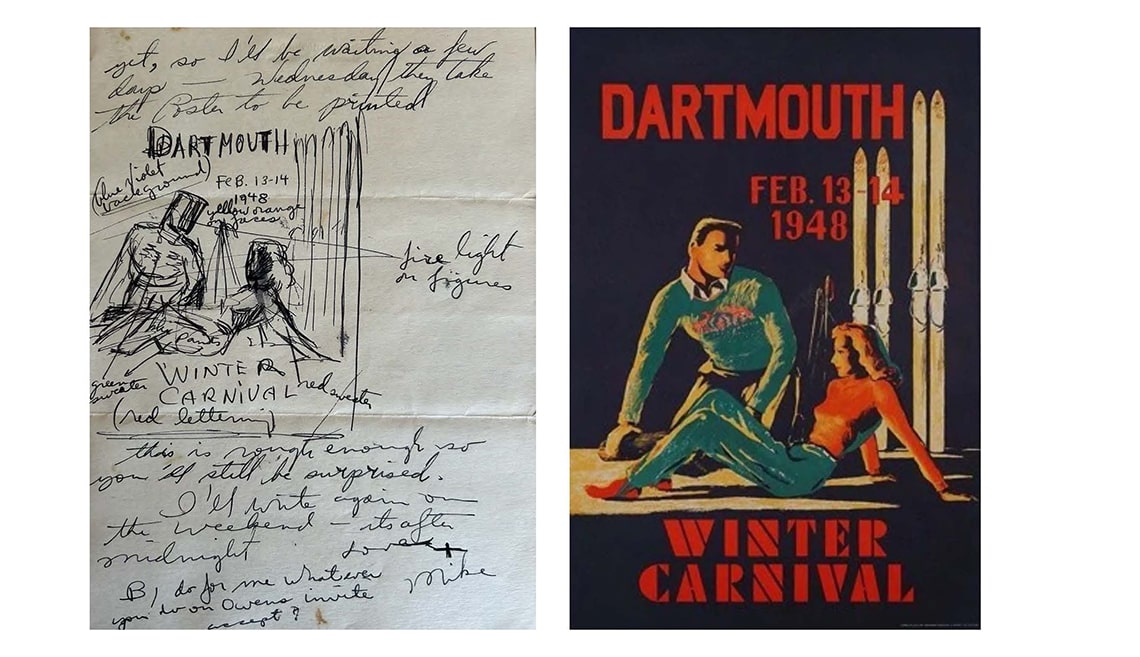
Mike won the competition for the Dartmouth Winter Carnaval competition in 1948. The poster remains to this day one of the “favorite” posters of Winter Carnaval. The letter on the left was written to his parents and his sister “B” just before the poster was printed.
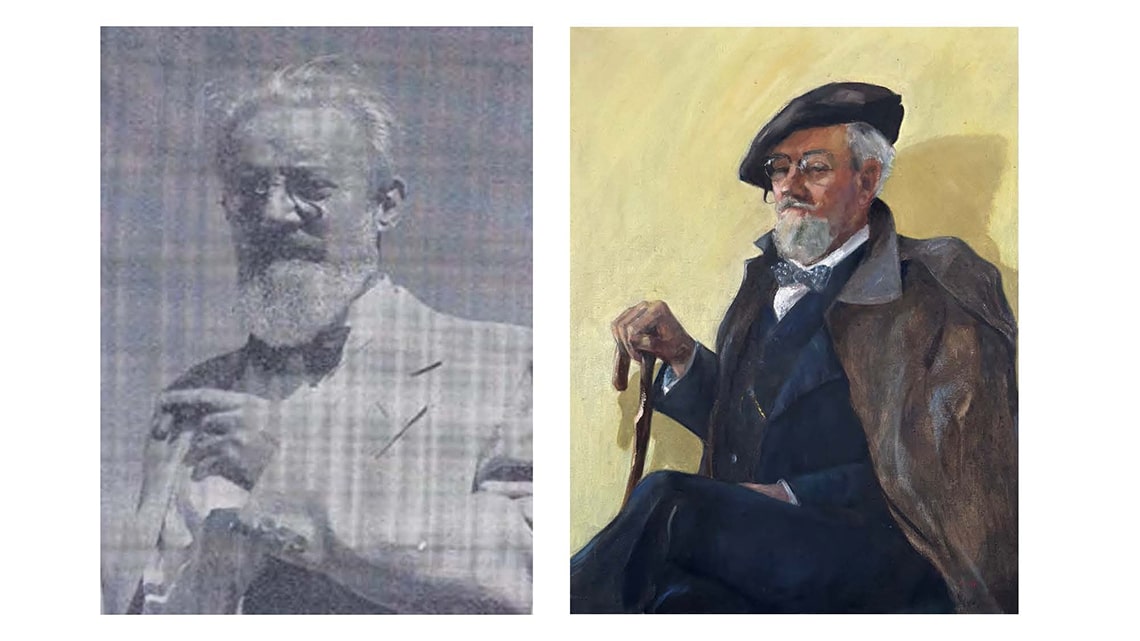
In 1949, Mike was commissioned to paint the portrait of Dartmouth English Professor David Lambuth. This portrait hangs to this day in Sanborn Library.
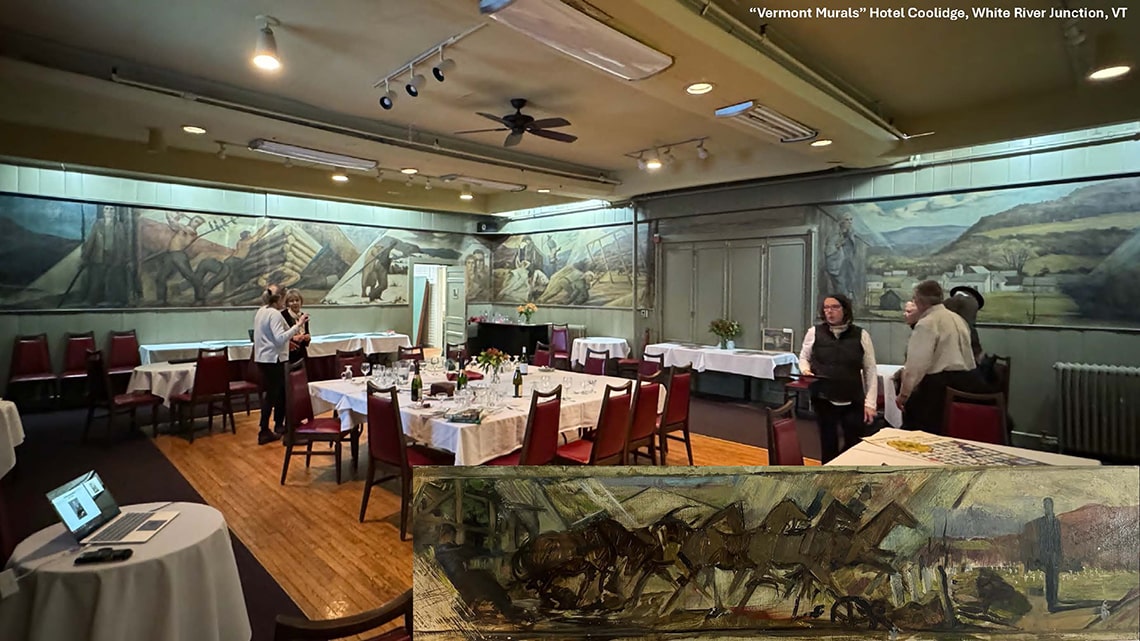
One of the fondest memories I have of the murals is spending a weekend when I was 15 helping Mike “restore” the canvases that had started to fall into disrepair.
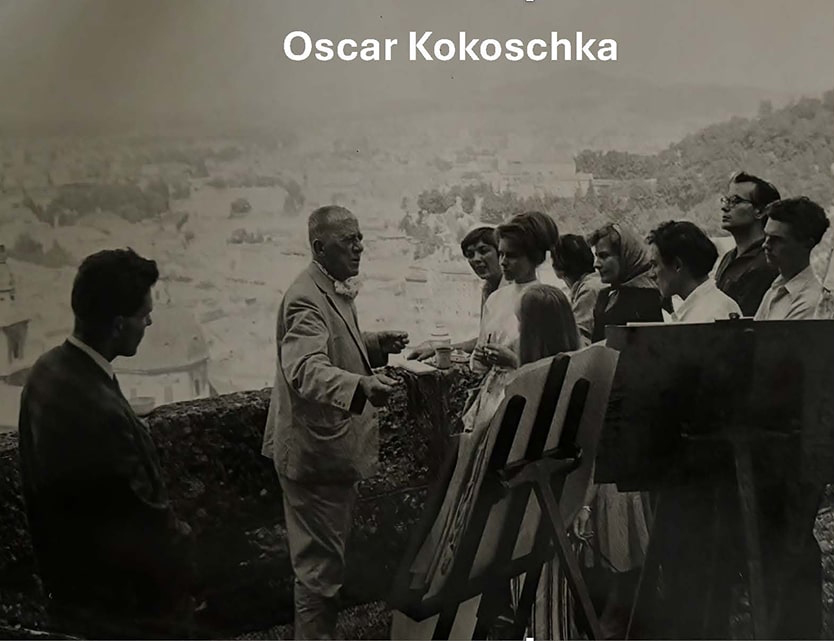
In the Summer of 1956, Mike attended classes at the “School of Vision” in Salzburg founded by famous Austrian Painter, Oskar Kokoschka. Mike went on to become Kokoschka’s apprentice for the period of 1957-1958. The school’s mission was to revive humanist ideals in the horrific aftermath of a war which changed Europe beyond recognition.
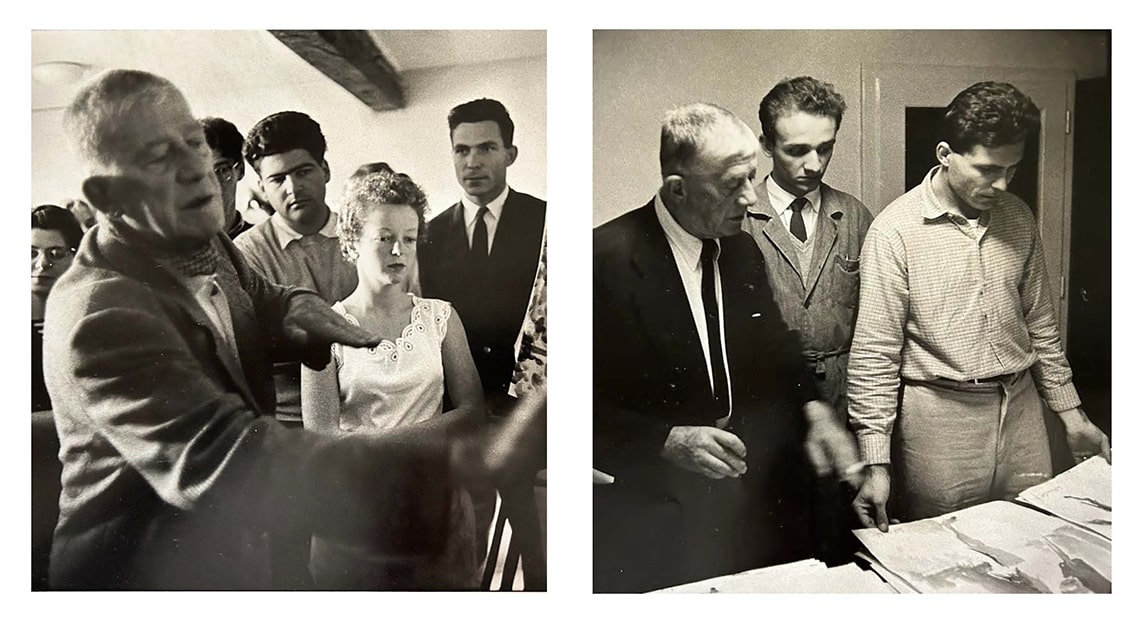
These two photos pay tribute to Mike’s relationship with the great Austrian Painter. It is worth noting that Kokoschka emphasized the importance of interacting directly with the subject matter and recording directly what the painter was seeing. In a letter to Kokoschka dated December 1973, Mike wrote: “One of the great things you taught is the celebration of life. ‘Occupy yourself with the Form, the sentiment will take care of itself…” (Later in the same letter to Kokoschka, Mike referred to Vietnam) “It is a beautiful county, and this applies also to the people; not only in the physical appearance of girls dressed in Ao-Dais, but in their movement as well: Their gestures – it is something that would have enhanced your School of [Vision].”
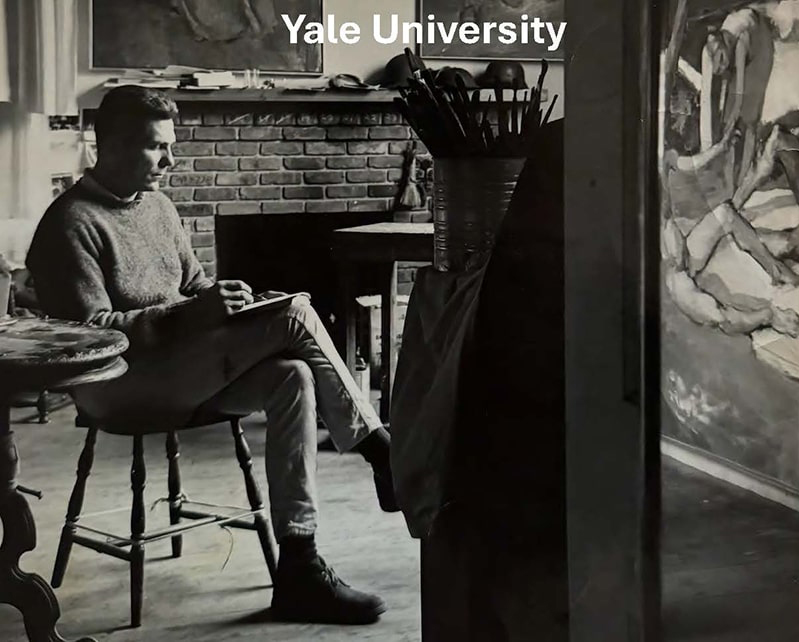
In 1962, Mike matriculated to Yale University to pursue a Masters Degree in Fine Arts. He studied with the well-known painter, Neil Welliver. Mike struggled against the post-modernist art trend of emphasizing “plasticity” over “Form” in the pursuit of art. This may have reflected the influence of Kokoschka who disliked intensely modern art. Mike finished his degree in 1964.
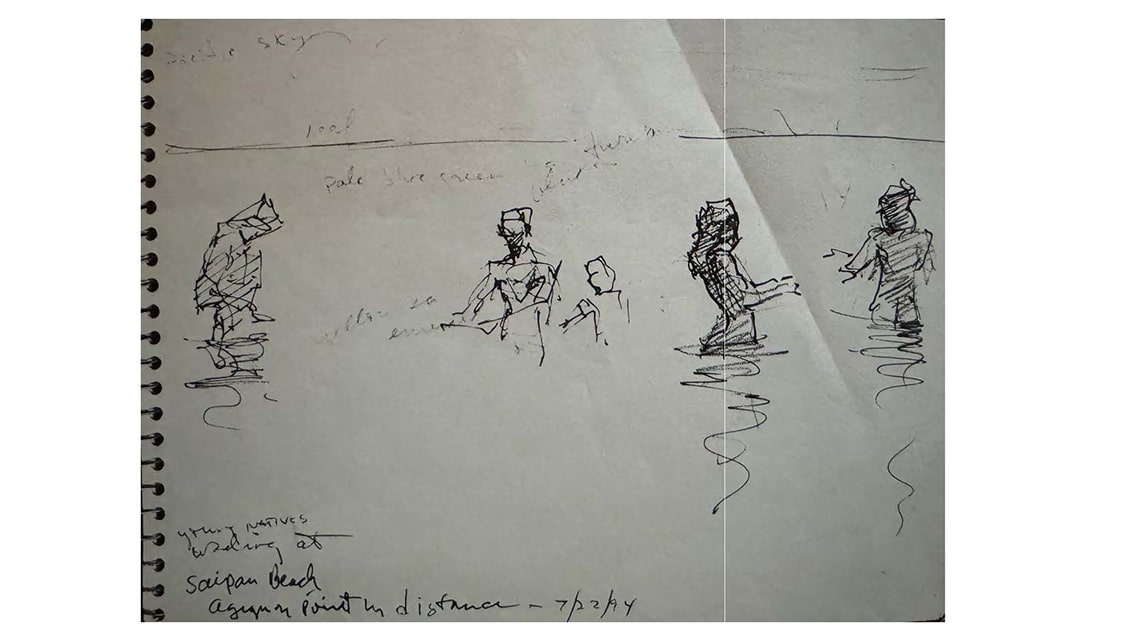
After Yale, Mike would continue to record in hundreds of sketch books what he was seeing in the “real” world. I chose this sketch done in 1994 because it is typical of how Mike viewed his work, always recording with utmost precision and accuracy what he saw while making copious notes of his observations. It is worth noting that sketches done by Mike decades before show the same discipline.
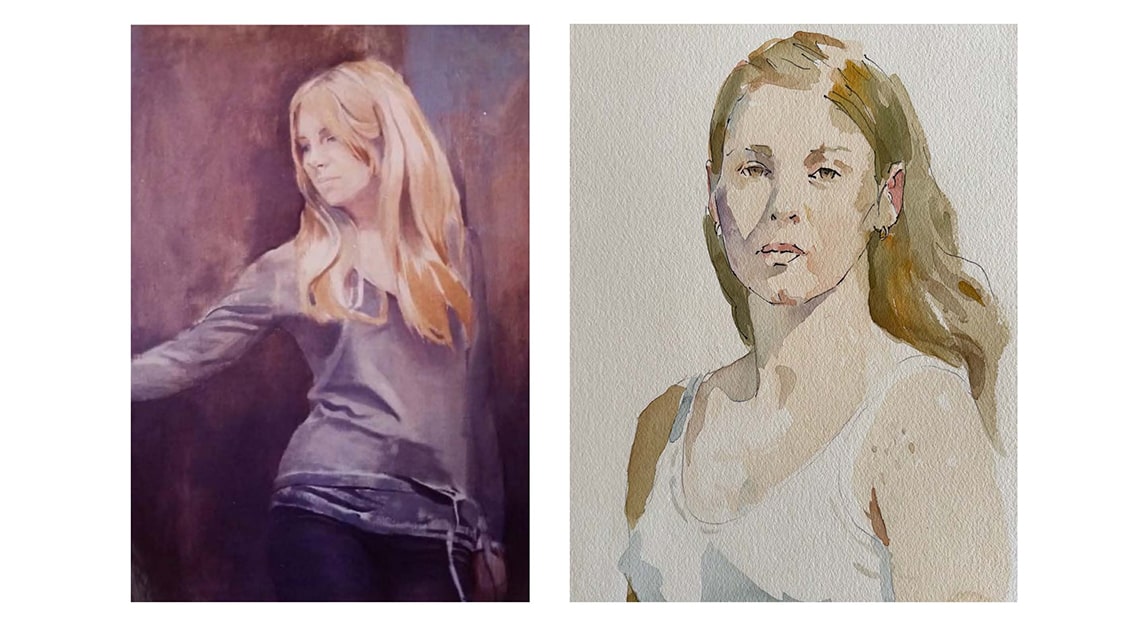
Mike loved beauty, sometimes expressed in the female form. These portraits capture in oil and watercolor the spontaneous moment when he was able to capture the “essence” of his subject matter.
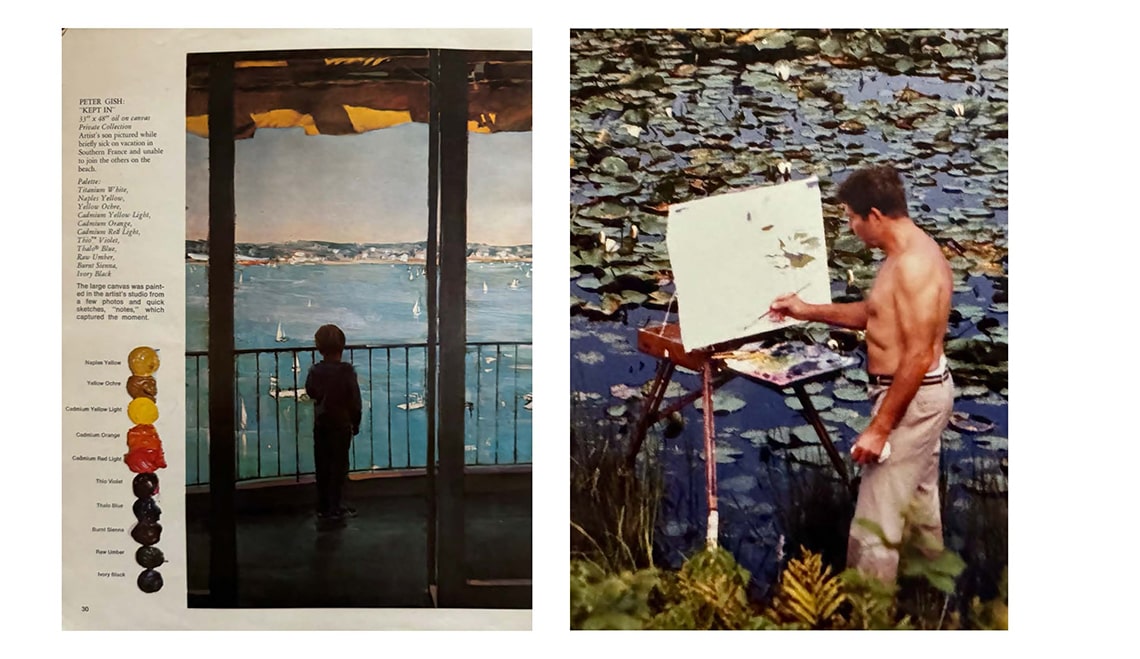
The image on the left is from a publication on painting that Mike did for Grumbacher entitled “The Art of Painting from the Masters.” The caption reads in part: “The large canvas was painted in the artist’s studio from a few photos and quick sketches ‘notes’ which captured the moment.”
The image on the right if of Mike standing in pond painting water lilies. It shows with absolute candor how Mike would prevent nothing from standing between his subject matter and his easel.
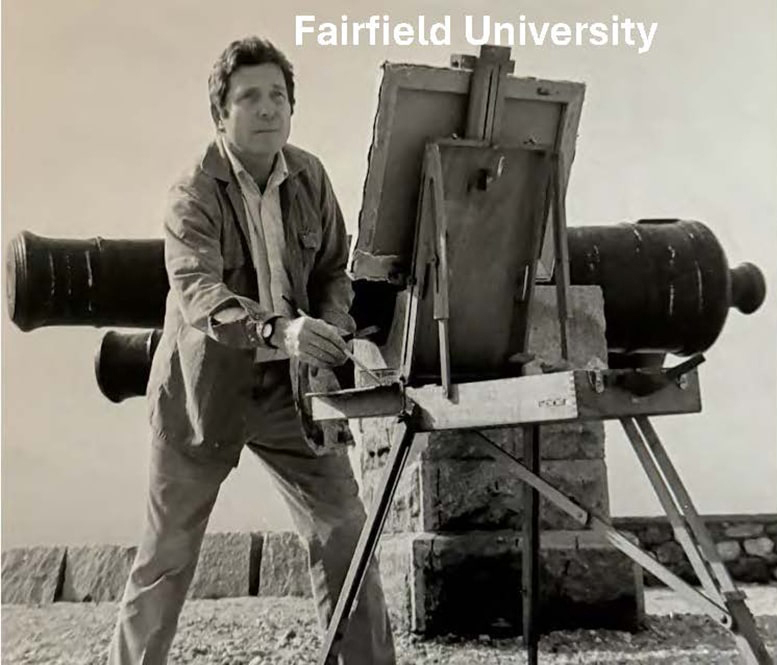
In 1971, Mike joined the faculty of Fairfield University as an Associate Professor of Art. Mike became a tenured member of the faculty in 1980. For his sabbatical year, he chose to spend 6 months in France painting the cliffs of Etretat in Normandy, France. We know from correspondence that Mike was a very well-liked and respected professor. We will have the good fortune to hear from one of his former students shortly.
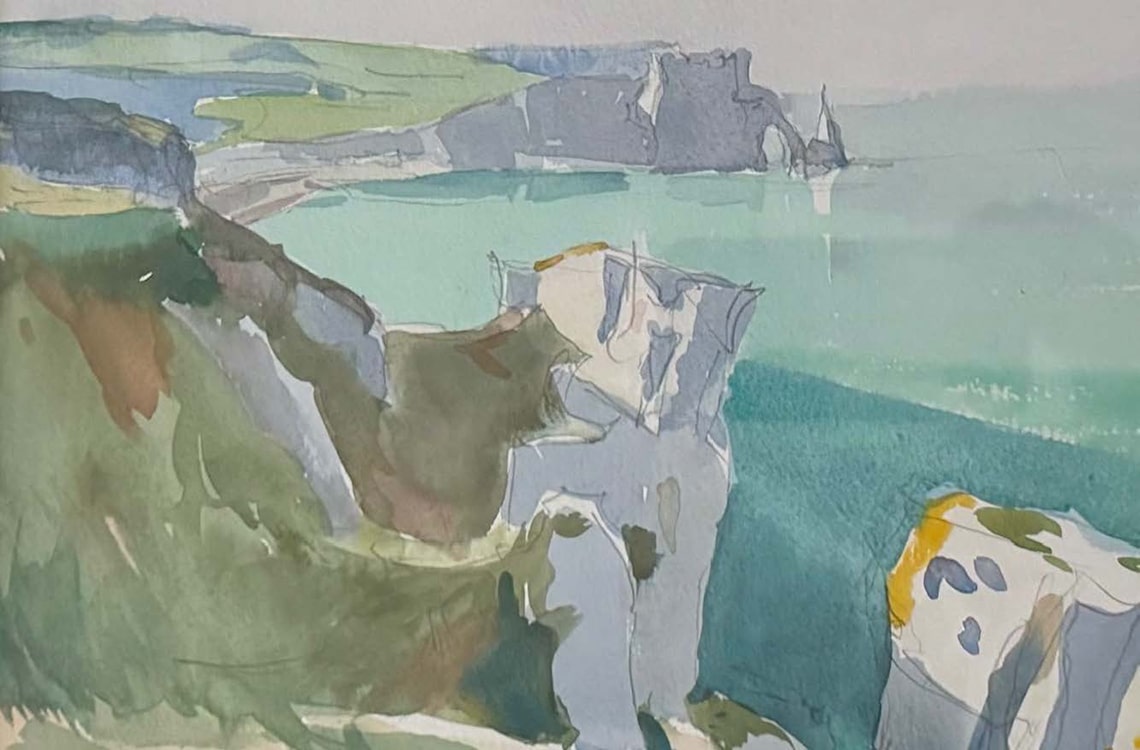
This is one of several dozen watercolors Mike did of the cliffs of Etretat.
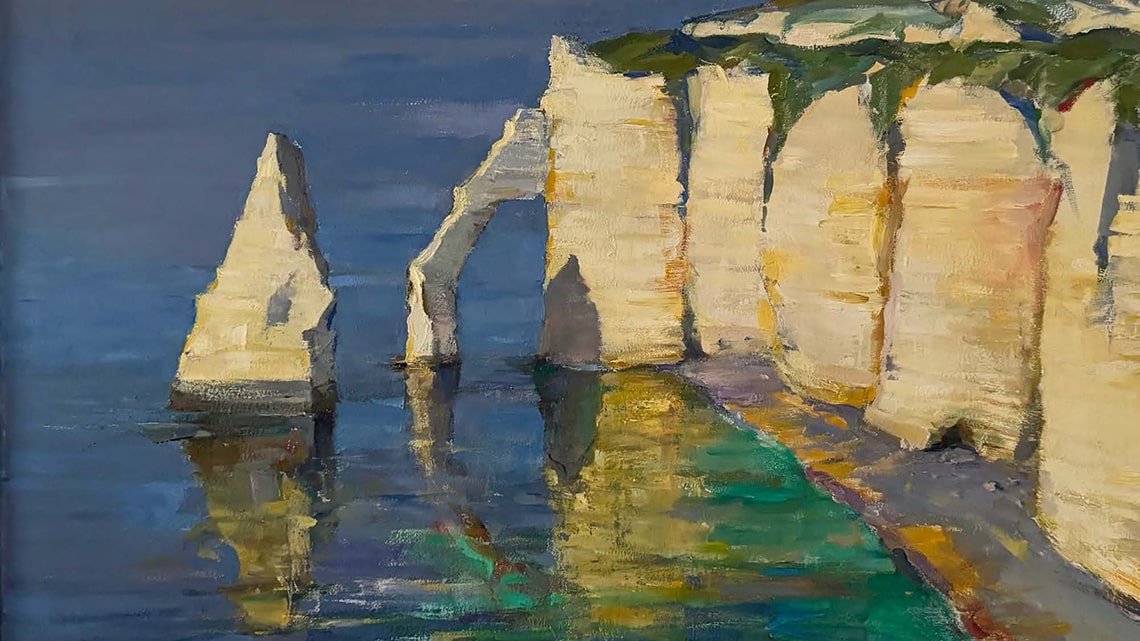
This oil painting was also one of many oil paintings Mike did during his Sabbatical from Fairfield University.
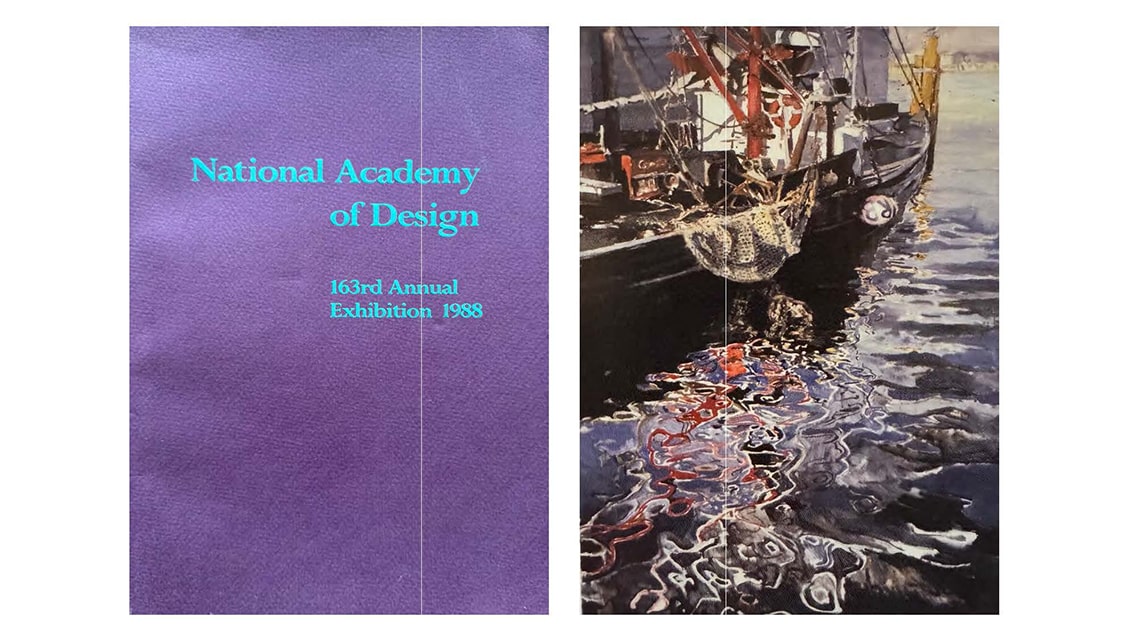
Throughout his tenor at Fairfield, Mike never stopped painting. He continued to have gallery exhibitions as well as private commissions. In 1988, one of his paintings was accepted (again) to the National Academy of Design. I find this painting particularly interesting as Mike started to explore abstraction in reflection of the water, illustrating his willingness to expand his boundaries.
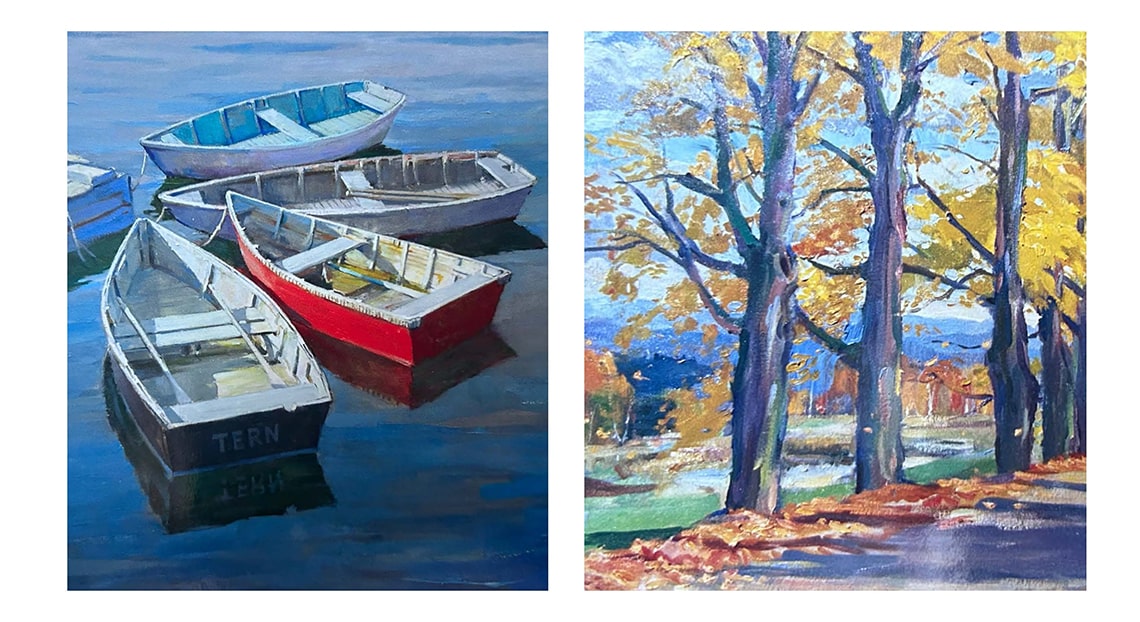
After retirement from the military and teaching, Mike continued to paint extensively. He gravitated towards Block Island, Rhode Island where he spent thousands of hours painting. He also found time to capture the change of seasons in New England.
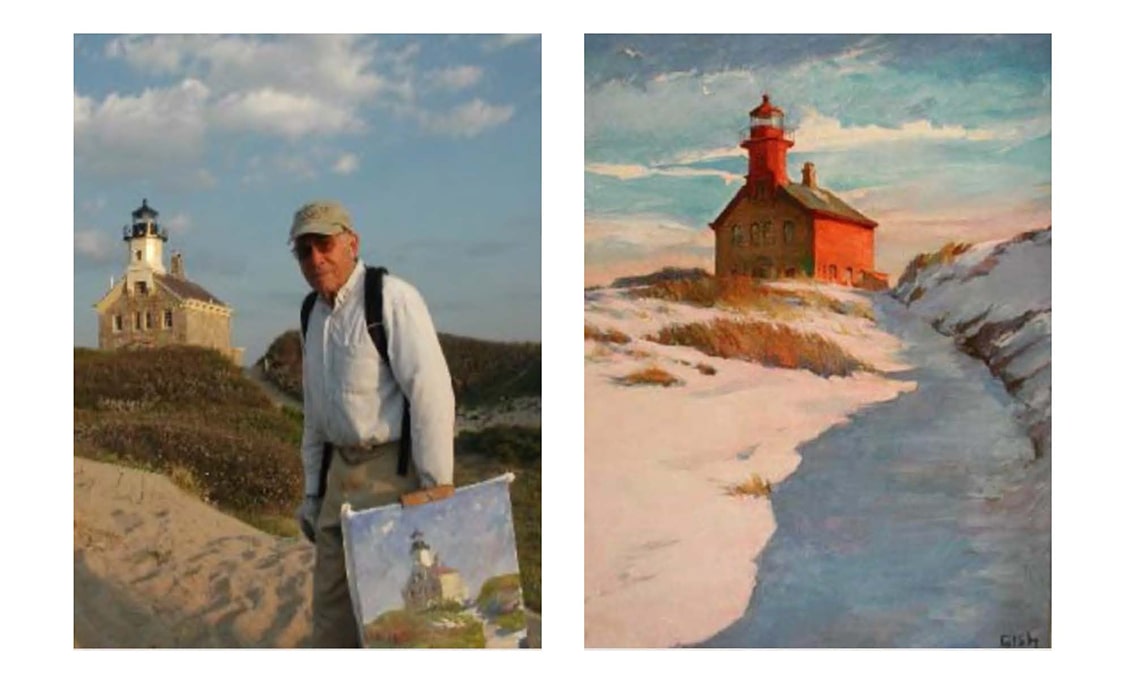
This photo was taken when Mike was almost 90. The oil painting on the right was produced following many studies.
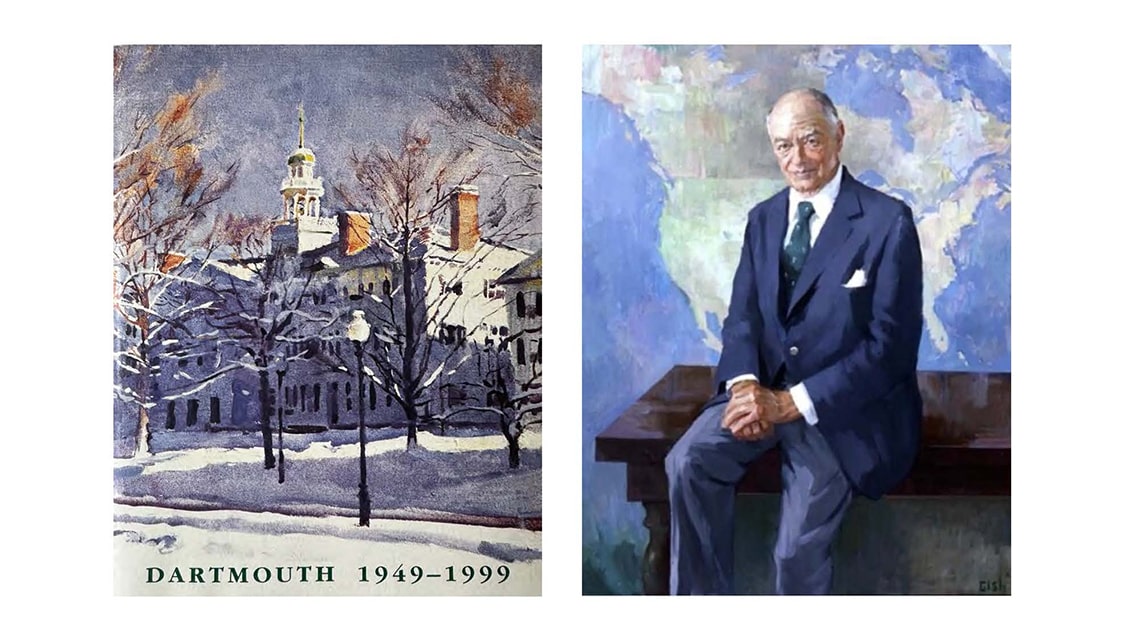
Before concluding with family, I thought it important to say a few words about Dartmouth College. Mike had a deep affection for the College and close ties to his class of 1949. Across campus are portraits he made of Professor Lambuth, artist Paul Sample and Secretary of the College, Sid Hayward. For his 50th reunion, mike painted Dartmouth Row in Winter and auctioned the artwork to raise money for his class. Mike was commissioned to paint the official portrait of John Sloan Dickey in 1980 and decided to paint the portrait in the room above the Tower Room of Baker Library. I had the privilege to climb the tower stairs my freshman year and witness my dad painting John’s portrait. He told me at the time that John wanted his portrait painted with his “head in Canada and his heart in the United States.”
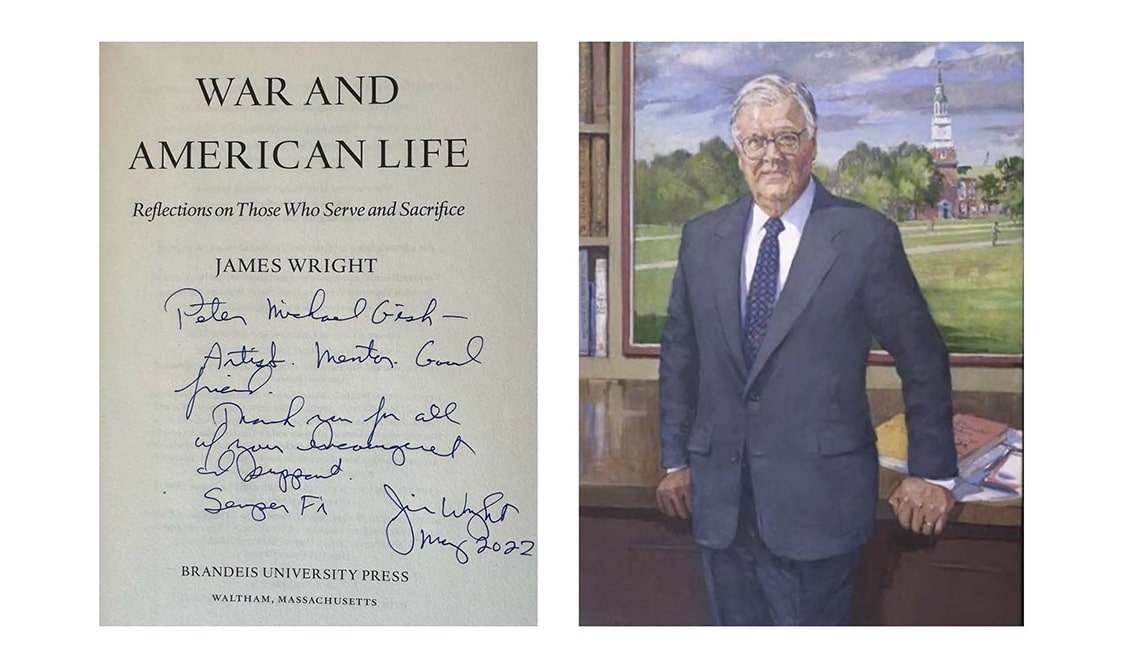
Mike painted the official portrait of James Wright three decades later. Sharing a common link with the US Marine Corps, Jim Wright and Mike became good friends. Jim gave Mike an inscribed copy of his last book, copied here, 6 months before he died. Susan Wright wrote to me recently saying: “[Had Jim been alive,] he would have spoken directly of your father’s brave early career, his grief and his love for your uncle, who was his inspiration. Jim would of course have told a story about your dad’s deep ties to Dartmouth while offering a history lesson, no doubt about sending the young to war and adding his own view on thoughtless policies. The impact that Peter [Michael] had on Jim personally in his later life would form the arc of the eulogy… Because of your father, Jim found new purpose. He died fulfilled by his work honoring and remembering veterans – all thanks to your father having initiated Jim’s contact with the appropriate office(rs) [in the Marine Corps]. Your father deserved to be remembered at his memorial service by Jim. I am certain that Jim [would have] expressed his gratitude, admiration, and affection [for] your father.
++++++++++++++++++++++++++++++++++++ FAMILY++++++++++++++++++++++++++++++++

In 1954, Mike met his future wife, Marguerite Drouin, on the train to Washington D.C. Born in Paris, Margot was French and had grown up in Saint Jean de Luz during the German occupation in WW II. Her father had fought in the French Cavalry during the battle of Pau in 1914 and had his left arm amputated in the field after being buried alive for 24 hours following a German artillery attack. Her mother was English and descended from English Aristocracy. Margot lived in Morocco for three years during her early childhood while her father worked for Standard Oil in the Maghreb. Margot studied languages at the University of Lausanne and was a translator at the U.N. when she met Mike. They had 3 children, Charlotte, Peter & Carl.

These are photos of me and my sister with my Mum sometime in 1964 and then of me and my brother circa 1968 in Westport, CT.
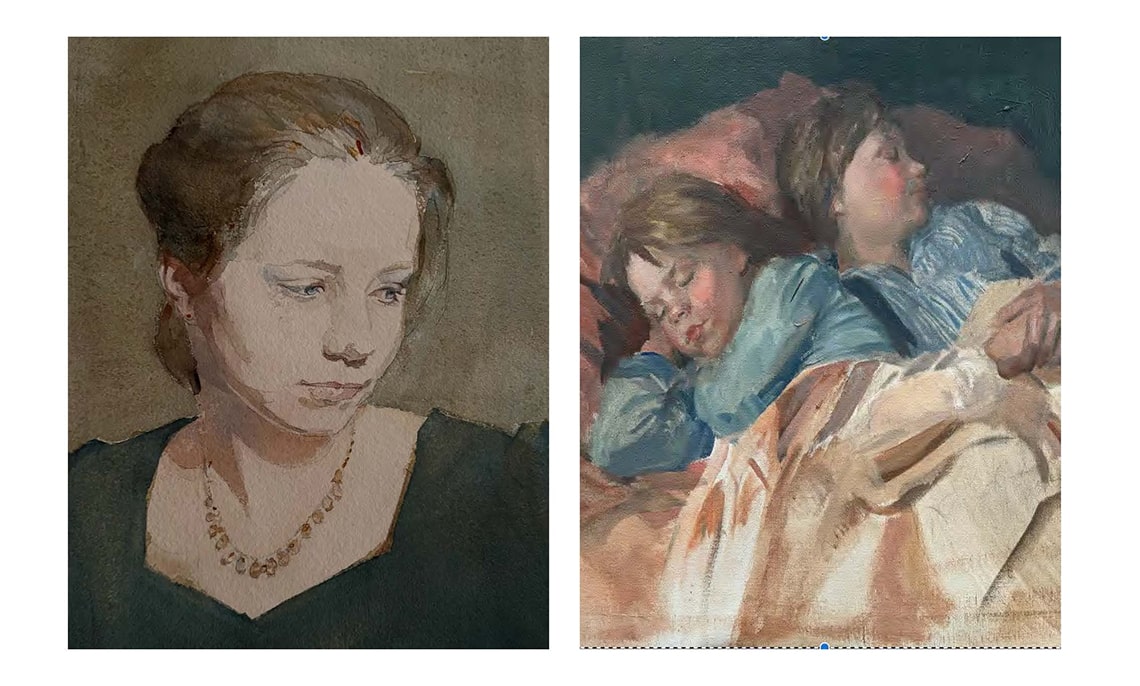
Mike painted his children many times. The watercolor on the left is of Charlotte and the oil painting on the left an oil painting of me and my brother Carl.
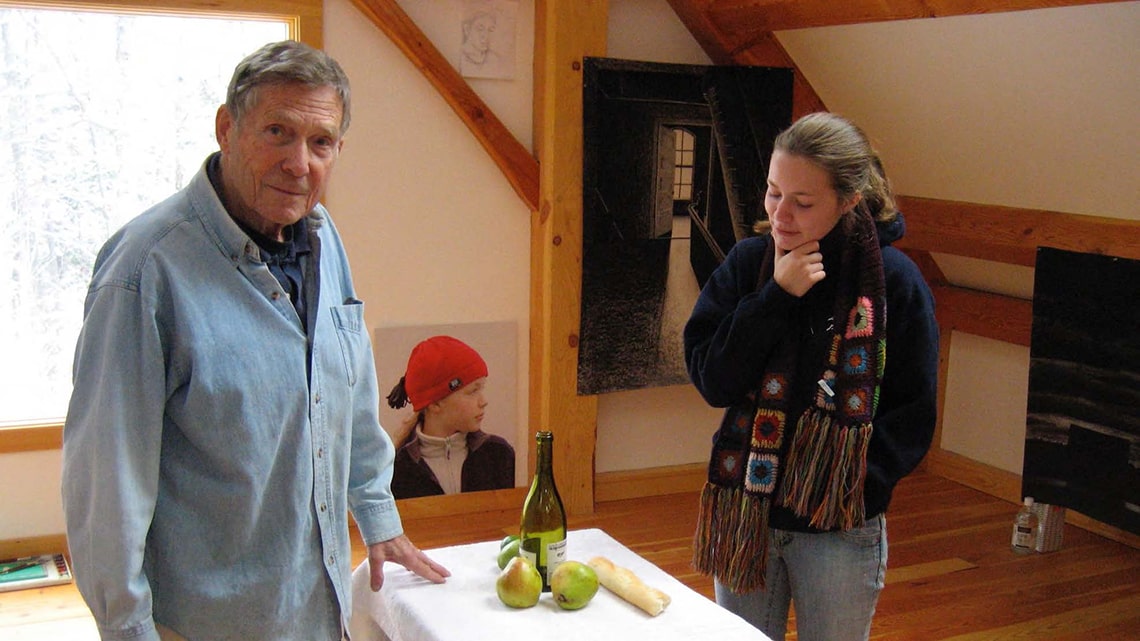
Mike had 7 grandchildren, including my three daughters and Dartmouth College graduates, Sophia, Miranda and Olivia. In this last image, Mike was painting with his three granddaughters in the studio at our mountain home in Thornton, NH.

I will conclude by saying a few words about my relationship with my father. The term “complicated” would barely do it justice. After much reflection and soul-searching, I realized that I could keep the most important and positive memories and jettison other, less interesting ones. Art and aviation were our common shared passions. He taught me to draw and paint from the earliest age (photo on the left) and included me in painting trips and outings throughout my life as I continued to learn from his example and instruction. Later in life as I was trying to exhibit in NYC, he provided me with invaluable mentorship (photo on the right). I am eternally grateful that he imparted to me the ability to have a deep and profound artistic perception of the world in which we live.
